Arezzo
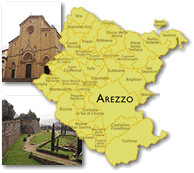
The fortunate geographic location on the slopes of mountains rich in woods and on the margins of a plain traversed by innumerable rivers, has guaranteed the availability of raw materials essential for ceramic production since antiquity. This explains the birth, precisely in Arezzo during the first half of the I century B.C., of the most widely diffused and utilised ceramic in the Roman world: sigillata. Arezzo maintained a role of primary importance throughout Tuscany also in the centuries that followed, becoming the seat of prestigious institutions and giving birth to major figures of Italian scientific history.
[Given the limitations on traffic in the historical centre, we advise you undertake the proposed itinerary on foot]
Ideal place to begin this journey is the sixteenth-century palazzo that houses the Museo Statale d'Arte Medievale e Moderna. Its collection of majolica and ceramics, among the most important in Italy, is flanked by a very interesting collection of Tuscan glass, made between the 16th and 18th centuries.
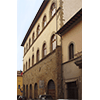
Housed in the sixteenth-century Palazzo Bruni Ciocchi, the Museo Statale di Arte Medievale e Moderna is one of the most important cultural institutions in the Arezzo area. With two main art collections, coming from the Municipal Pinacoteca and the Museum of the Laymen's Brotherhood, it contains, in addition to a fine collection of nineteenth-twentieth century paintings, numerous terracottas by Andrea della Robbia and his followers, an important collection of Italian majolica and one of glassware, as well as unusual collections of gemstones and coral. The majolica collection, one of the finest in Italy, contains numerous pharmaceutical jars coming from the Monastery of Camaldoli. Several objects in the glassware collection (beakers, goblets and jars, fabricated in the Tuscan glassworks of the 16th and 18th centuries) come instead from ancient pharmacies.
(Anna Toscano)
Continuing on Via Ricasoli, you walk along the impressive Gothic mass of the Cathedral of Arezzo, the interior of which merits a visit to see the funerary monument of famous scientist Francesco Redi who was from Arezzo.
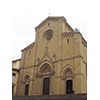
The construction of the Cathedral of Arezzo (San Pietro Maggiore) began around 1278, but spanned various epochs, indeed lasting until the early 16th century. The facade which had remained unfinished in the 15th century, was rebuilt in the 20th century in the neo-Gothic style on a design by Dante Viviani. Three stone measures of reference dating to the 13th century are walled on the south wall. The interior is a fine example of Gothic architecture, and abounds in works of art of great value.
Left of the entrance, near the sumptuous Chapel of the Madonna del Comforto, the funeral monument to Arezzo scientist Francesco Redi bears his family coat of arms. A bust of the scientist sits above the coffin.
The affairs around Redi’s body remain enigmatic to this day. He died after an apoplectic fit during the night of March 1, 1697 in Pisa, where he had gone with the Medici court. After an autopsy ordered by Grand Duke Cosimo III himself, his body was embalmed. The body was then moved to Arezzo and buried with great solemnity in the Church of San Francesco, in compliance with his testamentary wishes. In 1812, during the Napoleonic municipality, there was talk of transforming the church of San Francesco into a theatre. Worried for the destiny of the body, Redi’s great grandson Francesco Saverio had the funeral monument transferred to the Cathedral, but thereafter all trace of the body has been lost. Despite painstaking research conducted by scholars of local history, it is today impossible to say just where the mortal remains of the Arezzo doctor lie.
(Graziano Magrini)
A little farther, the harmonious architectural volume of Piazza Grande is dominated, on the northern side, by the elegant facade of Palazzo della Fraternita dei Laici. Of great scientific interest is the ingenious clock dating to the mid 16th century, and one of the best preserved of its kind in Italy.
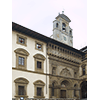
In Piazza Grande, also known as Piazza Vasari, stands the elegant building of the Fraternita dei Laici, a benevolent association founded in 1262, and still today at the centre of the city’s charitable activities. Begun in the late 14th century and completed between the 15th and 16th centuries, the building wonderfully combines the Gothic and Renaissance styles.
On the facade of the sixteenth-century bell tower, we can admire the extraordinary quadrant of the clock. Dated 1552, the ingenious clock is by Felice da Fossato. The bell tower houses the complex mechanism with the gearing and wheelwork which enable the various parts of the instrument to move; a meridian line served to check its precision, based on solar noon. The beautiful quadrant shows the hours, as well as the motion of the Sun and the phases of the Moon. In addition to the 12 Roman numerals, an inner circle bears 29 Arabic numerals which coincide with the days of the lunar month, while a copper disk bears geometric figures corresponding to the various positions of the Moon (treciles, quartiles and sextiles). Two metal spheres on the disk and a third one external to it respectively represent the earth, at the centre according to the Ptolemaic system still in vogue at the time the clock was built, the moon, half white and half black, and the sun. It should be pointed out that it is quite rare to find clocks of this type still existent today. In recent years, it has been perfectly restored.
(Fausto Casi)
Continuing onward, we come to the Prato promenade which offers a magnificent view of the Medici fortress, erected in the 16th century on the site of the city’s ancient acropolis.
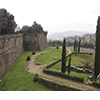
In 1538, as part of the revisions to the State defensive system ordered by Cosimo I de’ Medici, work began on the fortress and the new walls of Arezzo, under the direction of Antonio da Sangallo the Younger who utilised the drawings of Giuliano (1502) and Antonio the Elder (1505).
The Medici stronghold rises on the hill of San Donato on an area first occupied by buildings in the 3rd – 2nd century B.C., and then by a keep in the 14th century. It is an interesting example of sixteenth-century military architecture for its plan in the form of a five-pointed star, the rationality of its structures, and the innovation of architectural solutions. A peculiar feature of the walls instead consists of the considerable height of the scarp compared to the plumb wall. Dismantled in 1800 by the French, the fortress was restored in 1868 and successively reworked several times. At the end of the 19th century, Count Enrico Falciai Fossombroni willed the fortress and bordering land to the Commune of Arezzo so that it should be used for common good.
Today a public park, the area around the Medici fortress offers a beautiful panorama over the city, the plain, the Arno river valley and Pratomagno.
(Graziano Magrini)
Take Corso Italia up to the point where, on the left, it crosses Via dell’Anfiteatro which leads directly to the Museo Archeologico Nazionale Gaio Cilnio Mecenate. The medieval monastery of San Bernardo, which stands on the remains of an amphitheatre built under Hadrian, preserves among other things, an important section dedicated to sigillata and its complex production techniques.
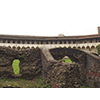
Hosted in the former monastery of San Bernardo, built around the mid 14th century on the remains of a Roman amphitheatre by the Benedictine Olivetan order, and restructured in the 17th and 18th centuries, the Archaeological Museum of Arezzo houses a vast collection of ancient artefacts, mainly from the Etruscan and Roman epochs. It contains a large number of very famous pieces, such as the splendid Attic krater by Euphronios and, from the scientific viewpoint, is especially important for the rooms devoted to the production of Arezzo terra sigillata. This very fine dining-table ceramic, has decorations in relief and is coated with a coral red paint. Produced in series with dies, it was popular from the mid 1st century B.C. to the middle of the following century. The exhibition illustrates its production techniques, and rooms VI, VII and VIII present pieces from the main workshops, of which we can cite those of M. Perennius and C. Ateius.
(Elena Fani)
****************************
Texts by Elena Fani
English translation by Victor Beard
Last update 09/ott/2008



 = libraries and archives
= libraries and archives  = scientific research centers
= scientific research centers  = memorial places of scientists
= memorial places of scientists = public health places
= public health places = places of science and worship
= places of science and worship = places of technology
= places of technology  = museums and collections
= museums and collections  = villas and gardens of science
= villas and gardens of science


